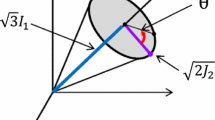Abstract
Following a recent participation in Sandia Fracture Challenge 2017, in which we identified some shortcomings associated with the peridynamic theory in predicting large deformation and ductile fracture, we recently proposed a bond-associated, semi-Lagrangian, peridynamic model that addresses the noted limitations. The new theory is employed to revisit the challenge problem. Our results show that the new approach significantly improves the predictions of ductile fracture phenomenon in this challenge.






Similar content being viewed by others
References
Bai Y, Wierzbicki T (2008) A new model of metal plasticity and fracture with pressure and lode dependence. Int J Plast 24(6):1071–1096
Behzadinasab M (2019) Peridynamic modeling of large deformation and ductile fracture. PhD thesis, The University of Texas at Austin
Behzadinasab M, Foster JT (2019) The third Sandia fracture challenge: peridynamic blind prediction of ductile fracture characterization in additively manufactured metal. Int J Fract 218:97–109
Behzadinasab M, Foster JT (2020a) On the stability of the generalized, finite deformation correspondence model of peridynamics. Int J Solids Struct 182:64–76
Behzadinasab M, Foster JT (2020b) A semi-Lagrangian, constitutive correspondence framework for peridynamics. J Mech Phys Solids 137:103862
Brozzo P, Deluca B, Rendina R (1972) A new method for the prediction of formability limits in metal sheets. In: Proc 7th Biennal Conf IDDR
Flanagan D, Taylor L (1987) An accurate numerical algorithm for stress integration with finite rotations. Comput Methods Appl Mech Eng 62(3):305–320
Foster JT, Xu X (2018) A generalized, ordinary, finite deformation constitutive correspondence model for peridynamics. Int J Solids Struct 141:245–253
Johnson GR, Cook WH (1985) Fracture characteristics of three metals subjected to various strains, strain rates, temperatures and pressures. Eng Fract Mech 21(1):31–48
Kramer SL, Boyce BL, Jones A et al (2019) The third Sandia fracture challenge: predictions of ductile fracture in additively manufactured metal. Int J Fract 218:5–61
Parks ML, Littlewood DJ, Mitchell JA, Silling SA (2012) Peridigm users’ guide v1. 0.0. Sandia report 7800
Wellman GW (2012) A simple approach to modeling ductile failure. Sandia National Laboratories, Albuquerque, NM, Report No SAND2012-1343
Wierzbicki T, Bao Y, Lee YW, Bai Y (2005) Calibration and evaluation of seven fracture models. Int J Mech Sci 47(4–5):719–743
Acknowledgements
The authors are grateful for the financial support provided by the AFOSR MURI Center for Materials Failure Prediction through Peridynamics: Project NO. ONRBAA12-020. M. Behzadinasab also acknowledges the fellowship funding by The University of Texas at Austin.
Author information
Authors and Affiliations
Corresponding author
Additional information
Publisher's Note
Springer Nature remains neutral with regard to jurisdictional claims in published maps and institutional affiliations.
Rights and permissions
About this article
Cite this article
Behzadinasab, M., Foster, J.T. Revisiting the third Sandia Fracture Challenge: a bond-associated, semi-Lagrangian peridynamic approach to modeling large deformation and ductile fracture. Int J Fract 224, 261–267 (2020). https://doi.org/10.1007/s10704-020-00455-1
Received:
Accepted:
Published:
Issue Date:
DOI: https://doi.org/10.1007/s10704-020-00455-1




